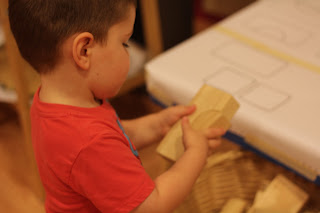Studying parts of the whole encourages flexible thinking by illustrating how larger objects are comprised of smaller objects. The purpose of this activity was to help children to think about perspective, symmetry and the relationship between shapes.
During breakfast we reviewed the following shapes: semi circle, square, large triangle, small triangle, bridge and rectangle.
I demonstrated how to change the configurations of two or more blocks to create a new larger shape.We discovered that there were at least 5 different ways to use the blocks to make a rectangle. We also looked at how we could make squares, circles and large triangles using the shapes in the unit block collection.
After our morning discussion, I set up a table with tracings of unit blocks in the configurations we discussed and a basket of blocks for the children to experiment with.
They came up with some interesting structures fueled by what they observed.
S worked on building rectangular towers from all of the rectangle configurations we discussed....
Here the kids are counting, identifing and "cutting" the larger shapes to make smaller shapes.
W and L worked with squares and triangles positioned them to make squares or square towers. W also commented several times on how turning the square on its side would make it into a diamond.....
A practiced matching shapes. She had to try several different ways to get the blocks to match the perspective of the tracings....
J worked on rectangles and squares comprised of the other shapes...
C Stacked towers up and knocked them down. She also worked hard to control her urge knock down other people’s towers and to be patient working with peers in a small space...
Things we learned: shape identification, putting two shapes together to make a new shape, matching skills, noticing size / shape similarities and differences of unit blocks, working together as a group in a small space, respecting the work of peers,
Later we painted a letter B with smaller wooden blocks and searched for B words on our morning walk.

























































